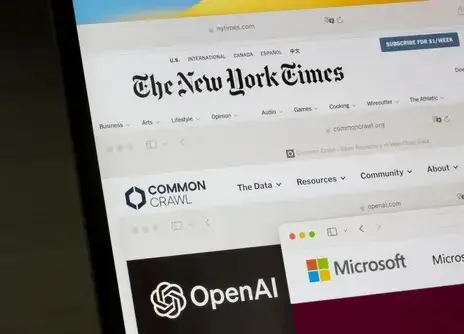
What is Twitter Moments, and how can publishers and journalists get featured on the site’s news curation tool to drive traffic? We found out for the latest in our Platform Profile series.
[See also:Instagram, NewsNow, Substack, Shutterstock, Upday, LinkedIn, Apple News/ Apple News+, Twitter, Acast, Authory, Pocket and TikTok].
Twitter’s “What’s happening?” sidebar has historically been an erratic mix of daily news, viral moments, and snippets of the internet’s inner monologue.
But in the past year or so, consciously packaged content from news sites has started to appear more frequently in that mix, offering emoji-decorated clarity amid the chaos.
Some publishers have figured out how to regularly get their work into the prime real estate of the “What’s happening?” sidebar driving serious traffic.
What are Twitter Moments?
A Twitter Moment is a string of tweets under a header image. Unlike Twitter’s more ubiquitous threads, though, a Moment doesn’t just have to be composed of your own tweets: you can add others’ into it, and you can order the elements within a Moment however you like, rather than just chronologically.
Any Twitter user can create a Moment. Some newsbrands use them to spotlight their work on Twitter in greater depth than would be allowed by a single tweet and in a way that means they can get picked up and featured by Twitter.
The Telegraph has particularly caught attention for its Moments frequently appearing in the “What’s happening” sidebar: readers may remember that Telegraph Moments were key in driving the brief viral panics around “geriatric millennials” and the idea of being “cheugy”.
At time of writing, Press Gazette’s own “What’s happening” sidebar features two Telegraph Moments — one on Kamala Harris’ attempts at an image reboot and another reporting the NHS will start sacking unvaccinated staff in February — both of which demonstrate that Moments don’t just have to have a lifestyle focus.
It’s not enough to just make a Moment to get it seen, though. To appear in “What’s happening”, you have to get your Moment into the Explore tab.
What’s the Explore tab?
The Explore Tab is a directory for what’s going on on Twitter. On desktop it appears right below the “Home” button, and on mobile it’s reachable via the magnifying glass button at the bottom of the app.
The Explore tab subdivides into sections like News, “For you”, and Trending. Trending shows the words, phrases and stories that are getting mentioned the most in your chosen region. However it is “For you” that feeds the “What’s happening” tab.
“For you” features a mix of the algorithmically served topics from Trending with Moments that have been approved for inclusion by a real person at Twitter.
Press Gazette asked Heather Bowen, Twitter’s senior partner manager for news, how Twitter determines which users see which Moments: could it, for example, choose to pin a particular Moment to “What’s happening?” so everyone in the UK could see it?
“It depends on a number of factors. For instance, if the story is globally relevant it might be made available to all English speaking markets globally, but if it’s UK specific it’ll likely only be shown to those in the UK.
“Then the algorithm will consider a range of things including – but not limited to – whether you follow or have engaged with that publisher handle before, whether you engage in news on the platform versus entertainment, whether that topic might be relevant to you based on the interests you’ve expressed historically and so on.”
How can journalists get Twitter to approve a Moment for Explore?
Bowen told Press Gazette: “Twitter has a global curation team who review all partner submissions. They ensure, for instance, that a partner’s Moments meet best practice and are accurate and balanced before they are featured.”
She added: “Anyone can curate a Moment, and Twitter may feature those Moments in the Explore tab. We review Moments before featuring them, to ensure they meet our overall curatorial standards.”
How The Telegraph gets featured on moments
David Knowles, The Telegraph’s head of social media, was generous enough to spill for Press Gazette a little bit of the secret sauce that gets The Telegraph featured so frequently in Moments.
First revelation: despite Bowen’s comment about partner submissions, Knowles’ team doesn’t talk to Twitter about its Moments.
“We don’t pitch to anyone at Twitter. Our social media team here at The Telegraph decides what stories to focus on and create.”
Since first publication of this article, Twitter has clarified to Press Gazette that while publishers may not “pitch” Twitter per se, its partners – including, it says, The Telegraph – do email their Moments over directly to Twitter’s curation team for consideration.
Regardless, The Telegraph has made a concerted drive to get its Moments featured. The publication was shortlisted for the Innovation prize at Press Gazette’s most recent British Journalism Awards for its Twitter Moments and Spaces launches.
“We’ve found our most successful Moments and Spaces are ones that bring to life the stories with the most depth – quick viral moments and the like often bounce off the surface – with interesting and original visual assets and added engagement offered by tools on Twitter.
“The Telegraph has an incredible depth to our journalism… bringing the user as close to our writers and reporters as possible is something that marks us out.”
That chimes with Bowen’s explanation for why publishers like The Telegraph get featured in “What’s happening” more often: “If one publisher has a lot of Moments featured it’s often because they have dedicated resources to create them regularly and have lent into best practice as part of their Twitter strategy.”
Andrew Barden, executive editor at Bloomberg’s social media video network Quicktake, also told Press Gazette his team does not talk to anyone at Twitter when they’re making their Moments.
That’s notable because Bloomberg has been partnered with Twitter since 2016: if anyone had an inside track to get their Moments featured, it would be them. (Incidentally, if you’ve ever wondered how Bloomberg gets all those vanity handles like @Business, @Technology and @Crypto, that partnership is why.)
As such, it seems as though Twitter’s curation team is always on the look out for notable Moments, both from its partners and other publishers.
On that note, how did The Telegraph hit on Moments as a way of driving traffic? By accident, it seems.
“As a team we follow the trends and data online, looking especially for where potential Telegraph readers spend their time,” Knowles said. “Last year we noticed how effective some of our initial Twitter Moments were so we scaled our publishing up to a full strategy across desks and accounts.”
What makes a good Twitter Moment?
For Twitter’s part, Bowen said: “A great Moment features original Tweets and Twitter content that is: timely, factual, impartial, creative, relatable, diverse, informative and/or entertaining for the reader. It provides context and delves into different angles of a story.”
A Moments 101 page on Twitter’s website gives some more specifics, for example:
- Except in breaking or developing news situations, Twitter says a “good rule of thumb” is for Moments to be eight to 12 tweets long
- Titles should be fewer than ten words or 280 characters and conversational
- Descriptions should be no longer than two sentences
- The ideal video is original source footage, 30-60 seconds long, and can be viewed without audio.
Show me the money
Asked whether Twitter pays publishers to feature them in “What’s happening?”, Bowen replied only that “we do have opportunities for publishers to earn revenue from Twitter and these opportunities are increasing – such as with the launch of products like Twitter Blue”, which sounds like a no.
But The Telegraph’s Knowles said Moments have been a meaningful driver of traffic.
“Moments and Spaces have brought our journalism in front of hundreds of thousands of new people a month who otherwise may never have encountered it. Many like what they see or hear and become subscribers – from there they go on to access all parts of the app and online product.”
Knowles didn’t provide any hard figures, saying only that: “When the stars align and a Moment gets featured and goes viral a huge number of registrations and subscriptions can follow.”
[Read more: Telegraph CEO Nick Hugh on how digital subs are safeguarding future of 165-year-old news brand]
But few would sniff at a few extra hundred thousand readers a month.
And some publishers are actively going after them: last month Reach advertised for a dedicated Moments producer role.
The verdict
Twitter Moments seem to be worth the effort. Thread your tweets just-so and a story that might have slipped between the cracks could instead get seen by thousands of people – and, crucially for some publishers, potential new subscribers.
The biggest drawback is that, as Reach’s job ad showed, The Telegraph is not the only publisher popping up regularly in the “What’s happening” tab these days. Titles as disparate as Metro, The Big Issue and The Sunday Times have also begun competing to get their headlines in Twitter’s spotlight.
But competing for eyeballs is hardly a new challenge for journalists. At its best, making proactive use of Twitter’s Moments feature may well expand your publication’s reach; at worst, you’ll just end up with a bundle of fancy threads that, even if they don’t get onto “What’s happening”, present your work in an accessible and visually pleasing way.
The big takeaway, as with so much in journalism, appears to be that if you invest time, effort and money into Moments, there are promising results to be had. But failing that, bagging a partnership with a social media behemoth can’t hurt either.
Email pged@pressgazette.co.uk to point out mistakes, provide story tips or send in a letter for publication on our "Letters Page" blog






